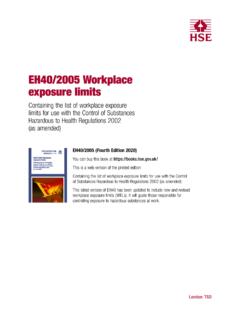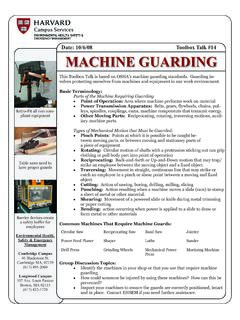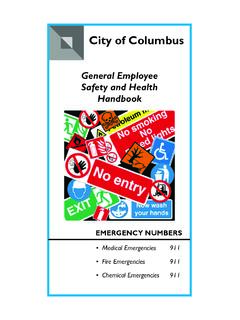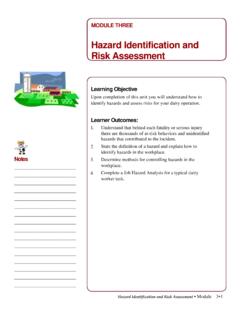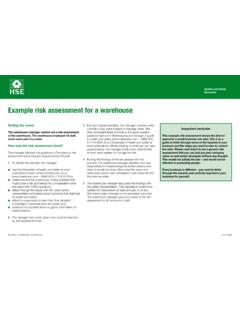Transcription of Five steps to risk assessment - Health and Safety ...
1 Further Information five steps TO RISK This booklet is available from HSENI or ASSESSMENTyou can download it from our website You can download the risk assessment template, worked examples and more detailed information on how to complete a risk assessment from HSENI s website, This leaflet contains notes on good practice which are not compulsory but which you may find helpful in considering what you need to do. For further information please contact: HSENI, 83 Ladas Drive, Belfast BT6 9FR Phone: 028 9024 3249 Follow usHelpline: 0800 0320 121 Email: Crown Copyright 2017. Printed by HSENI Mar 2017 v1 Web: HSE INDG163 (rev3) gratefully acknowledged as source 2 This leaflet aims to help you assess Health and Safety risks in the workplace A risk assessment is an important step in protecting your workers and your business, as well as complying with the law.
2 It helps you focus on the risks that really matter in your workplace the ones with the potential to cause real harm. In many instances, straightforward measures can readily control risks , for example ensuring spillages are cleaned up promptly so people do not slip, or cupboard drawers are kept closed to ensure people do not trip. For most, that means simple, cheap and effective measures to ensure your most valuable asset your workforce is protected. The law does not expect you to eliminate all risk, but you are required to protect people as far as reasonably practicable . This guide tells you how to achieve that with a minimum of fuss. This is not the only way to do a risk assessment , there are other methods that work well, particularly for more complex risks and circumstances. However, we believe this method is the most straightforward for most organisations.
3 What is a risk assessment ? A risk assessment is simply a careful examination of what, in your work, could cause harm to people, so that you can weigh up whether you have taken enough precautions or should do more to prevent harm. Workers and others have a right to be protected from harm caused by a failure to take reasonable control measures. Accidents and ill- Health can ruin lives and affect your business too if output is lost, machinery is damaged, insurance costs increase or you have to go to court. You are legally required to assess the risks in your workplace so that you put in place a plan to control the risks . How to assess the risks in your workplace Follow the five steps in this leaflet: step 1 Identify the hazards step 2 Decide who might be harmed and how step 3 Evaluate the risks and decide on precautions step 4 Record your findings and implement them step 5 Review your assessment and update if necessary Don t overcomplicate the process.
4 In many organisations, the risks are well known and the necessary control measures are easy to apply. You probably already know whether, for example, you have employees who move heavy loads and so could harm their backs, or where people are most likely to slip or trip. If so, check that you have taken reasonable precautions to avoid injury. If you run a small organisation and you are confident you understand what s involved, you can do the assessment yourself. You don t have to be a Health and Safety expert. If you work in a larger organisation, you could ask a Health and Safety adviser to help you. If you are not confident, get help from someone who is competent. In all cases, you should make sure that you involve your staff or their representatives in the process. They will have useful information about how the work is done that will make your assessment of the risk more thorough and effective.
5 But remember, you are responsible for seeing that the assessment is carried out properly. When thinking about your risk assessment , remember: n a hazard is anything that may cause harm, such as chemicals, electricity, working from ladders, an open drawer etc; n the risk is the chance, high or low, that somebody could be harmed by these and other hazards, together with an indication of how serious the harm could be. 44 33 step 1 step 2 Identify the hazards Decide who might be harmed and how First you need to work out how people could be harmed. When you work in a place every day it is easy to overlook some hazards, so here are some tips to help you identify the ones that matter: n Walk around your workplace and look at what could reasonably be expected to cause harm. n Ask your employees or their representatives what they think. They may have noticed things that are not immediately obvious to you.
6 N Visit the HSE website ( uk). HSE publishes practical guidance on where hazards occur and how to control them. There is much information here on the hazards that might affect your business. n If you are a member of a trade association, contact them. Many produce very helpful guidance. n Check manufacturers instructions or data sheets for chemicals and equipment as they can be very helpful in spelling out the hazards and putting them in their true perspective. n Have a look back at your accident and ill- Health records these often help to identify the less obvious hazards. n Remember to think about long-term hazards to Health (eg high levels of noise or exposure to harmful substances) as well as Safety hazards. For each hazard you need to be clear about who might be harmed; it will help you identify the best way of managing the risk. That doesn t mean listing everyone by name, but rather identifying groups of people (eg people working in the storeroom or passers-by ).
7 In each case, identify how they might be harmed, ie what type of injury or ill- Health might occur. For example, shelf stackers may suffer back injury from repeated lifting of boxes . Remember: n some workers have particular requirements, eg new and young workers, new or expectant mothers and people with disabilities may be at particular risk. Extra thought will be needed for some hazards; n cleaners, visitors, contractors, maintenance workers etc, who may not be in the workplace all the time; n members of the public, if they could be hurt by your activities; n if you share your workplace, you will need to think about how your work affects others present, as well as how their work affects your staff talk to them; and n ask your staff if they can think of anyone you may have missed. 66 55 step 3 Evaluate the risks and decide on precautions Record your findings and implement them step 4 Having spotted the hazards, you then have to decide what to do about them.
8 The law requires you to do everything reasonably practicable to protect people from harm. You can work this out for yourself, but the easiest way is to compare what you are doing with good practice. There are many sources of good practice, for example HSE s website ( ). So first, look at what you re already doing, think about what controls you have in place and how the work is organised. Then compare this with the good practice and see if there s more you should be doing to bring yourself up to standard. In asking yourself this, consider: n Can I get rid of the hazard altogether? n If not, how can I control the risks so that harm is unlikely? When controlling risks , apply the principles below, if possible in the following order: n try a less risky option (eg switch to using a less hazardous chemical); n prevent access to the hazard (eg by guarding ); n organise work to reduce exposure to the hazard (eg put barriers between pedestrians and traffic); n issue personal protective equipment (eg clothing, footwear, goggles etc); and n provide welfare facilities (eg first aid and washing facilities for removal of contamination).
9 Improving Health and Safety need not cost a lot. For instance, placing a mirror on a dangerous blind corner to help prevent vehicle accidents is a low-cost precaution considering the risks . Failure to take simple precautions can cost you a lot more if an accident does happen. Involve staff, so that you can be sure that what you propose to do will work in practice and won t introduce any new hazards. Putting the results of your risk assessment into practice will make a difference when looking after people and your business. Writing down the results of your risk assessment , and sharing them with your staff, encourages you to do this. If you have fewer than five employees you do not have to write anything down, though it is useful so that you can review it at a later date if, for example, something changes. When writing down your results, keep it simple, for example Tripping over rubbish: bins provided, staff instructed, weekly housekeeping checks , or Fume from welding: local exhaust ventilation used and regularly checked.
10 We do not expect a risk assessment to be perfect, but it must be suitable and sufficient. You need to be able to show that: n a proper check was made; n you asked who might be affected; n you dealt with all the significant hazards, taking into account the number of people who could be involved; n the precautions are reasonable, and the remaining risk is low; and n you involved your staff or their representatives in the process. There is a template at the end of this leaflet that you can photocopy and use or you can download it from our website If, like many businesses, you find that there are quite a lot of improvements that you could make, big and small, don t try to do everything at once. Make a plan of action to deal with the most important things first. Health and Safety inspectors acknowledge the efforts of businesses that are clearly trying to make improvements.
